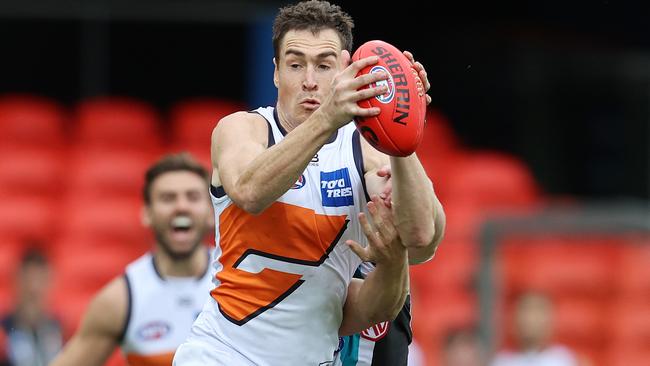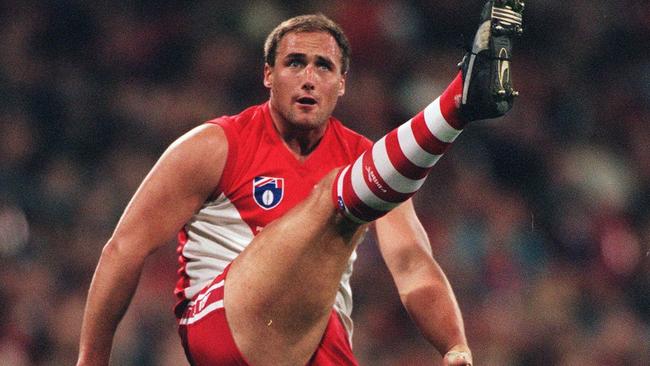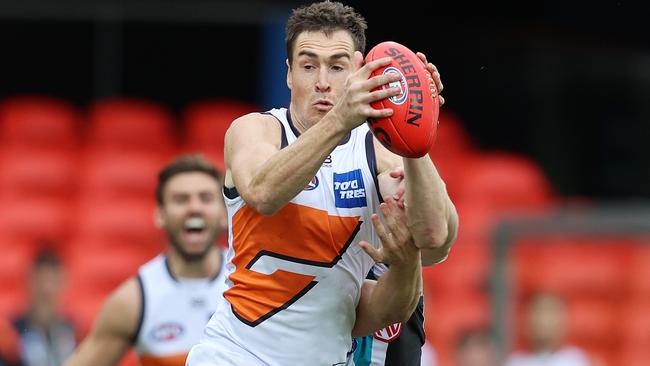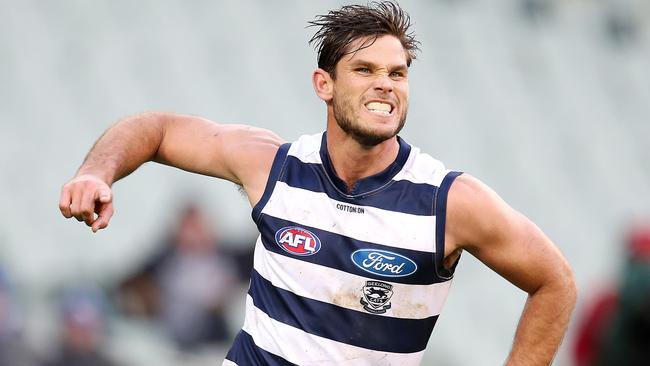Mick Malthouse explains the death of the full-forward, and how to bring them back
Power forwards are footy’s superstars, setting the game alight with big bags of goals. They have become almost obsolete in 2020, but they don’t have to be — if coaches listen to Mick Malthouse.

Expert Opinion
Don't miss out on the headlines from Expert Opinion. Followed categories will be added to My News.
Tony Lockett averaged more than seven goals a game in 1991.
“Plugger” won the Coleman Medal by kicking 127 goals from 17 games, including a final, and booted 10 or more goals in six matches. Unbelievable.
In the same year, Allen Jakovich averaged just more than five goals a game and Jason Dunstall (4.6), Peter Sumich (4.4), John Longmire (4.3), Billy Brownless (4.0) and Gary Ablett (2.3) had healthy averages.
They were the power forwards of the golden era.
AFL RICH 100: SEE FOOTY’S HIGHEST-PAID PLAYERS
The stats are similar for most seasons until early in the 2000s.
After seven rounds this year, Charlie Dixon has kicked 15 goals from six games. That’s an average of 2.5 an outing.
Tom Papley (medium half-forward) has also kicked 15 goals. Jeremy Cameron (13), Charlie Cameron (small forward, 13), Brody Mihocek and Ben King (both 12), and Josh Kennedy, Tom Hawkins and Tom Lynch (all 11) sit near the top of the Coleman Medal table.
Perhaps it’s hard to compare apples with apples this year with all its constraints, but in the past decade there has been an obvious decline in output from the power forward.
It has been 12 years since anyone kicked more than 100 goals in a season. Lance Franklin was the last with 113 goals in 2008.
But it’s less about the full-forwards and more about the structure, game plans and strategies of modern-day teams.
Kayo is your ticket to the 2020 Toyota AFL Premiership Season. Watch every match of every round Live & On-Demand. New to Kayo? Get your 14-day free trial & start streaming instantly >

Look at some statistical evidence.
In the 2000 Grand Final, Essendon and Melbourne piled on 30 goals. The Bombers amassed 332 disposals and the Demons 265.
In the 2019 Grand Final between Richmond and GWS, 20 goals were scored and each side had 365 disposals.
What did the Tigers and Giants do with those extra disposals?
In 2000, Matthew Lloyd and Paul Barnard kicked four goals each. In 2019 Jack Riewoldt kicked five and Tom Lynch two.
The likes of Lockett, Dunstall, Ablett, Sumich and Longmire didn’t venture far outside the forward 50. The team’s job was to get the ball into the scoring zone for the key and supplementary forwards to contest one-on-one for the ball and for a goal.
The best teams today have a structure when the ball comes out of the backline where the ball carrier has targets, both short and deep, in front of him.
This is called holding your line.
These teams work on the theory that they do not have to defend the back 50 with 14, 15, or 16 players and risk getting locked into defensive mode without an attacking alternative.
They back their backs and midfielders to defend the back half and to get the ball forward to the goalkickers.
Richmond, Collingwood, West Coast and Geelong are the standouts. Port Adelaide and Brisbane are quickly improving.
When the Tigers bring the ball out of the backline through Bachar Houli or Nick Vlastuin, they have Riewoldt short and Lynch deep as targets. Every time. As well as the crumbers.
It sounds simplistic, but the box formation has been around for a long time and it works — if it is consistently maintained.
Clearly, there is a stronger emphasis on defence in the modern game, with an extra player behind the ball, but don’t think for a second that this is only a modern-day tactic.
Ruckmen of the past were used as a stumbling block for the opposition by taking up a position in front of the key forward.
Perhaps the difference then was that teams had faith in their forwards in the one-on-one contest, or even two-on-one contests.
A fundamental flaw in today’s game is when it is played too safe.
A player marks the ball or is awarded a free kick and his first instinct is to look sideways or backwards, which leads to wasted possessions and a forward line deprived of opportunity.
It’s hard to fathom that they wouldn’t have more faith in their forwards to give them a contest. If it is a coaching directive to hold up the ball, then you live by your coach’s methods.
But if it is instinct to hesitate in delivering the ball forward, then you are putting your teammates under pressure by delaying the pass until they are often out of position.
A lot of clubs put ball retention above a contest, going for the short option to ensure ball security. This only denies forwards the opportunity of scoring.
Big-scoring forwards are not a thing of the past. Ben Brown kicked 10 goals last year against Port Adelaide. Riewoldt bagged 10 goals against Gold Coast in 2018. Franklin kicked 10 against Carlton in 2017.
But it is all about structure and how the ball is delivered to them.

The best sides move the ball quickly with confidence between the arcs. At the bare minimum the backline player with the ball wants to look up and see his forwards holding their structure in a box formation of four — two deep and two within interim reach — in front of him. He can kick it short, long, into the open, into a contest, whatever, as long as he provides his forwards with a contest before the forward 50 is swamped by the opposition.
That is where the power forwards can shine.
With all the attributes of past full-forwards, Jeremy Cameron could kick a 100 goals a season, but right now he is a long way off that.
The Giants, with outstanding ball users, are constantly deprived of forward targets.
Cameron, Jeremy Finlayson and Harry Himmelberg are regularly caught out being too far up field helping out in the backline, delaying entry into their forward 50 and denying the forwards opportunity to goal.
They consistently have low inside-50 numbers. How do they kick a big score when that’s the case?
You’re in real trouble if you have to defend with more than 14 players in the opposition’s 50.
The ball will just keep rebounding and by the time you get back to your own scoring zone it will be too crowded for a clean contest.
Brown this season is a victim of slow ball movement. Coupled with a loss of confidence and opponents knowing to knock him off balance before he leads, that has led to a big downturn in output from the North Melbourne forward.
The likes of Lockett, Dunstall and Ablett were genuine superstars. They were the go-to players, constant and consistent. They would come out to meet the ball, win the one-on-one contest, and kick the goal — even in a losing side.
Injury-free Charlie Dixon resembles the bully power forwards of the past. If he can work on his return, he could be the difference between Port becoming the real deal instead of the pretenders this year.

Josh Kennedy is a marvel and has been a regular, reliable target for West Coast because of its structure.
Tom Lynch relies on direct delivery from his Tiger teammates and works well playing deep with Riewoldt playing higher.
Tom Hawkins gives Geelong confidence to know he is on the lead and he is why the Cats have regularly played finals.
Cameron could be anything if the Giants structure allowed for it.
Brody Mihocek isn’t a big power forward, but he serves a great purpose for Collingwood as a target.
And the King twins — Ben at Gold Coast and Max at St Kilda — have the potential to be
unbelievable with more experience and growth. They each have agility, a strong mark, power, and an accurate kick. They are already impacting their team’s performances. I hope they stay at separate clubs to remain individuals.
The power forward is just as relevant and capable in today’s game. If they can hold their position and their teammates and have faith enough to give them a one-on-one contest, we may see more dominant targets emerge in the future. Let’s hope we do.
MORE FOOTY:
AFL player manager lifts lid on secrets of the trade, how to get best deal for his players
AFL Rich 100: How AFL player salaries compare to superstar athletes around the world
Moneyball: The latest trade news and whispers from around the AFL
Originally published as Mick Malthouse explains the death of the full-forward, and how to bring them back
